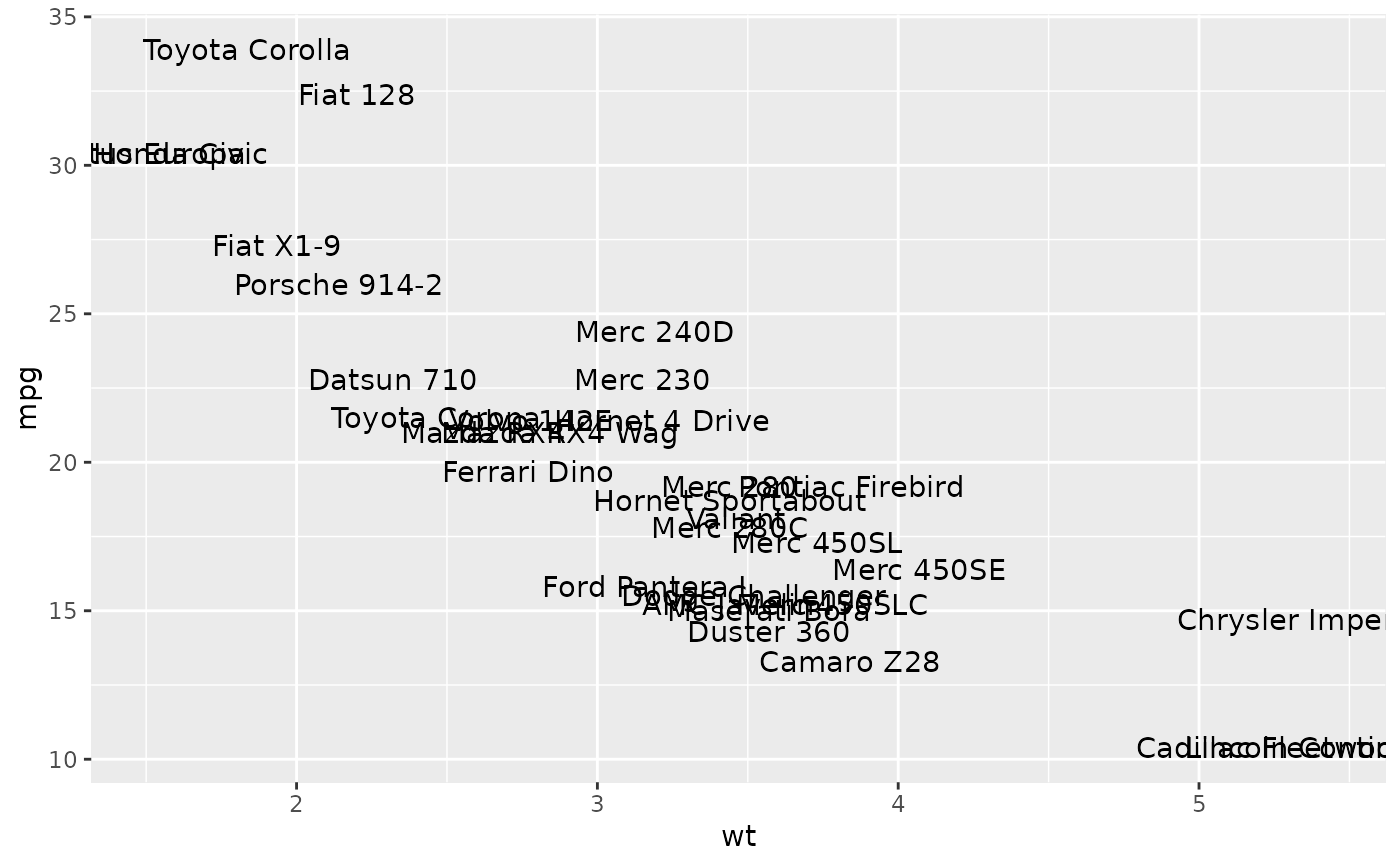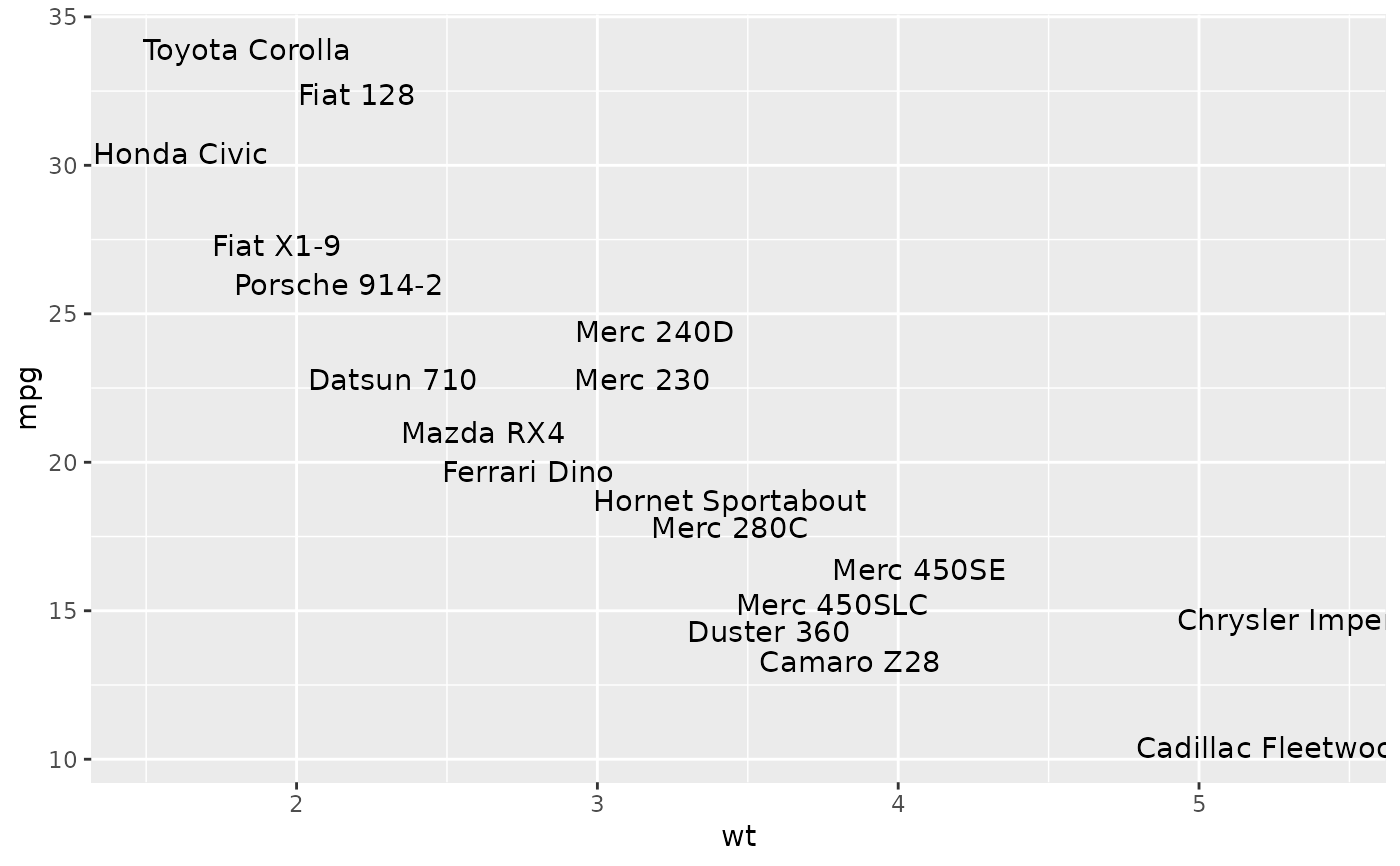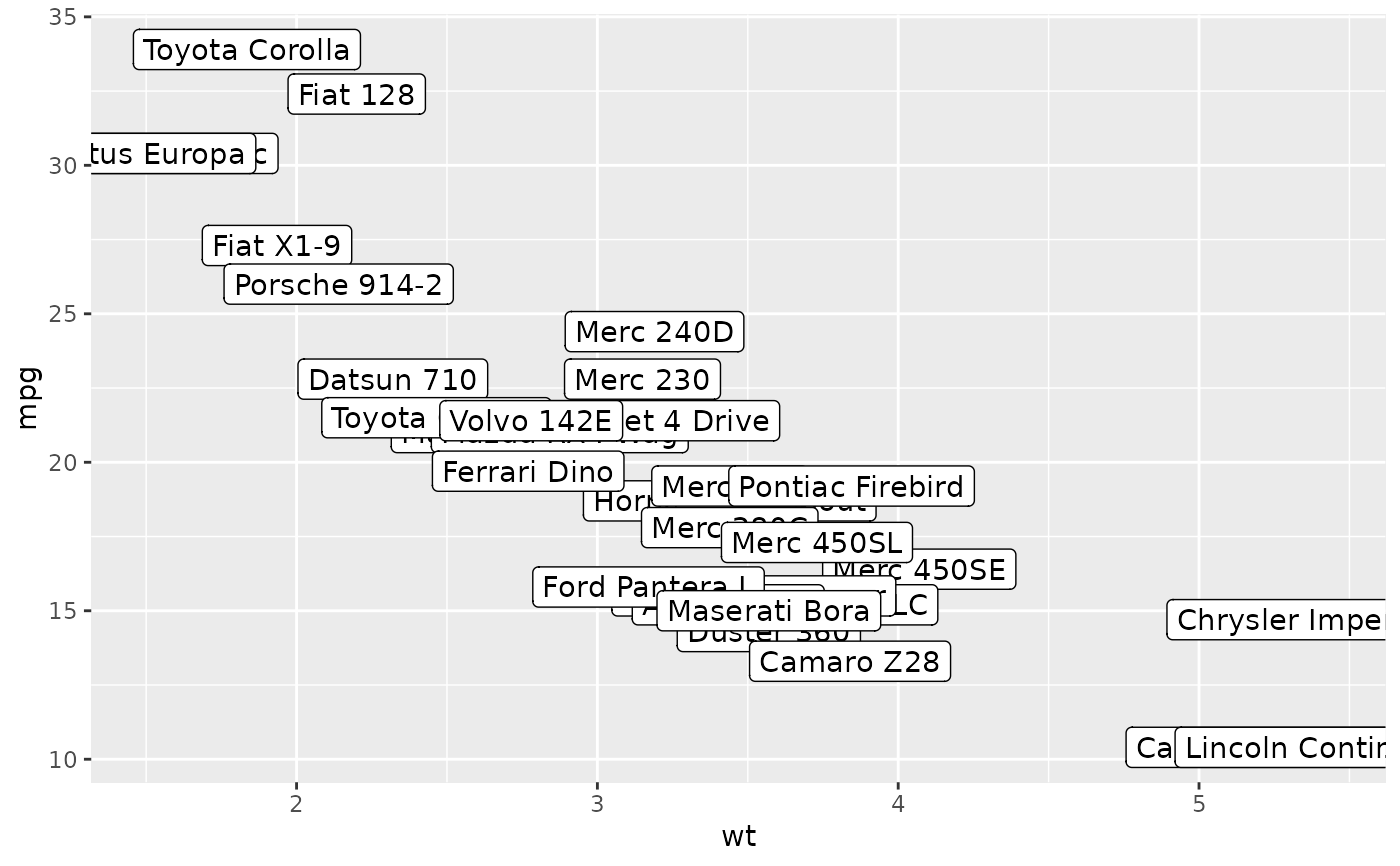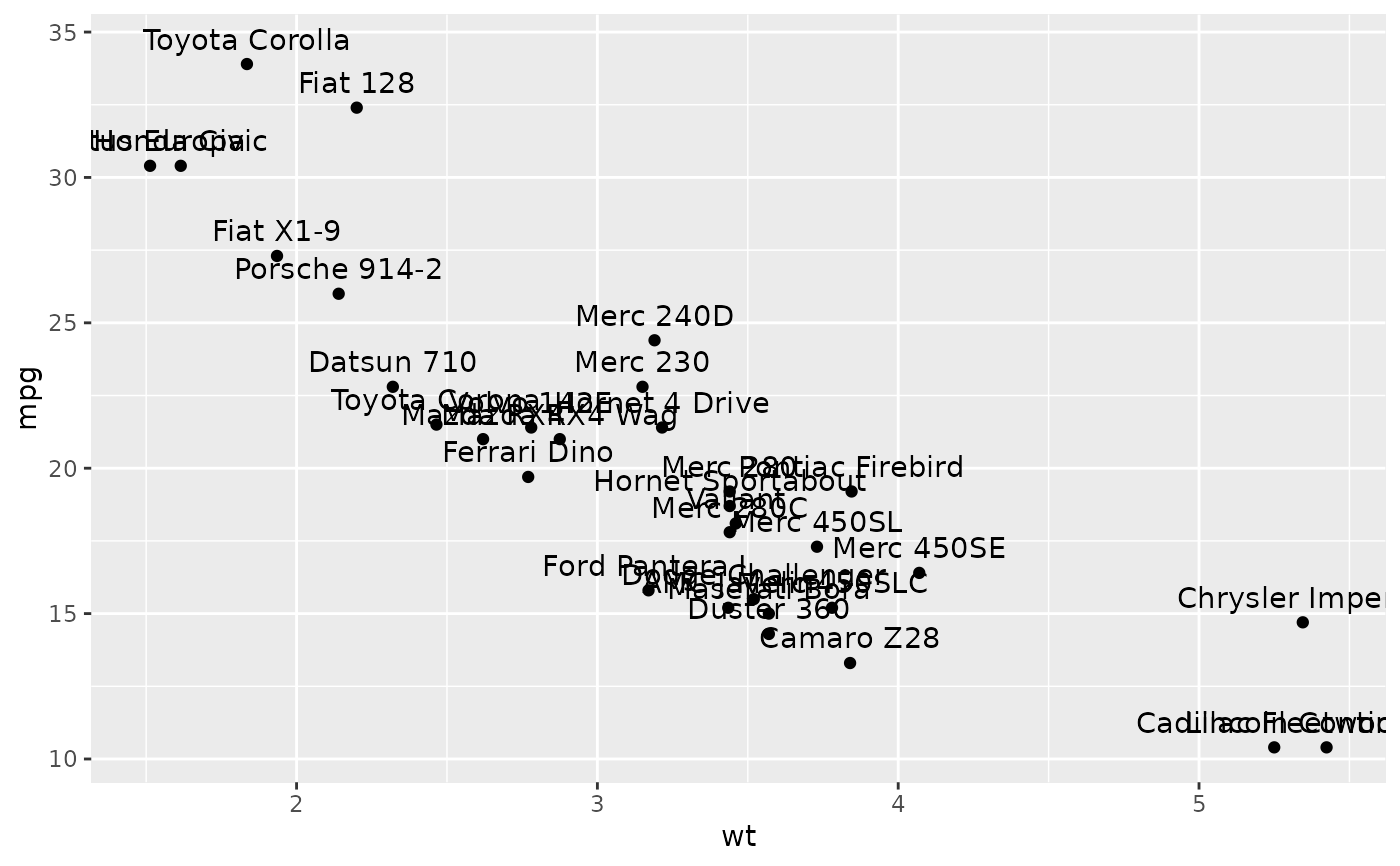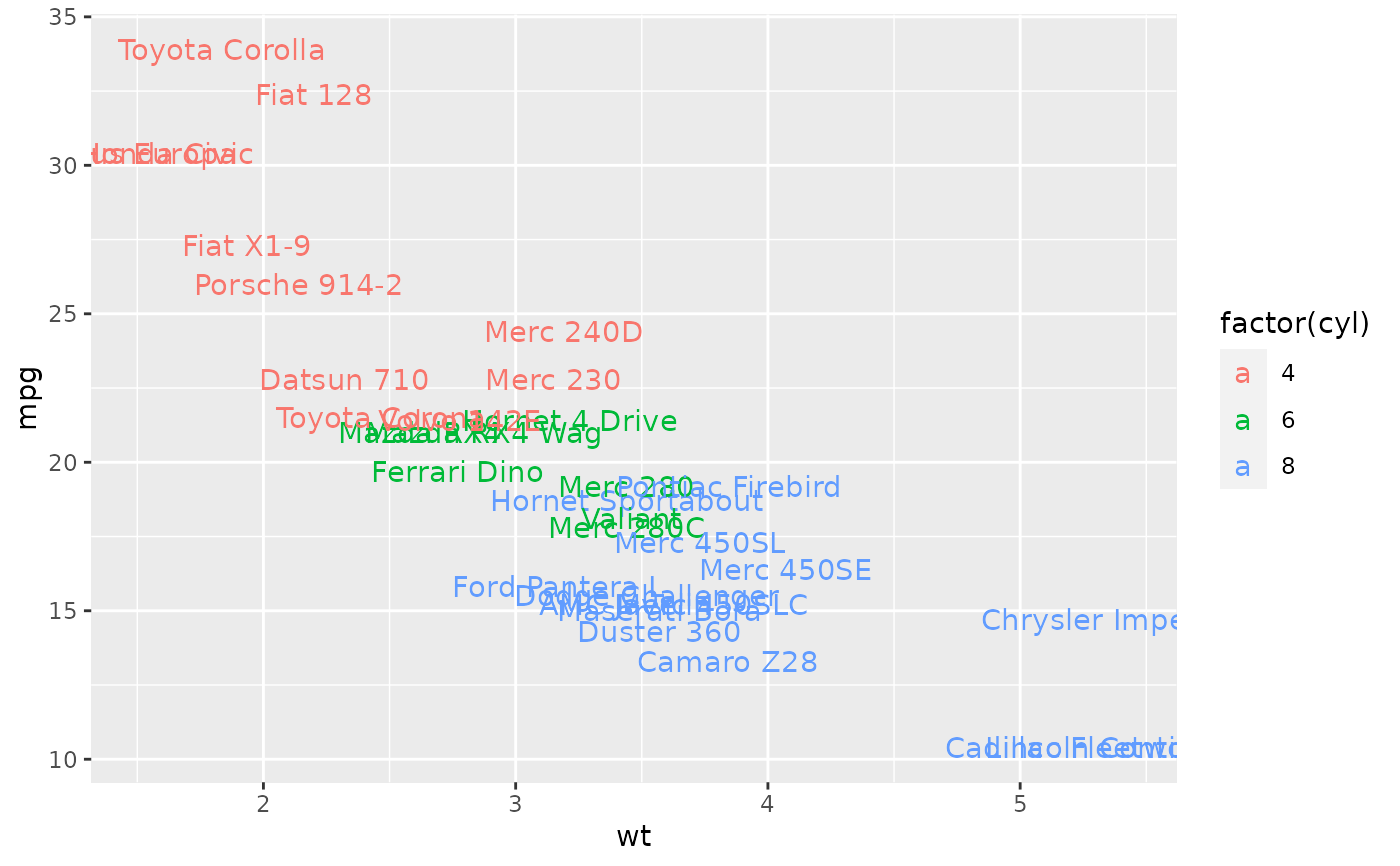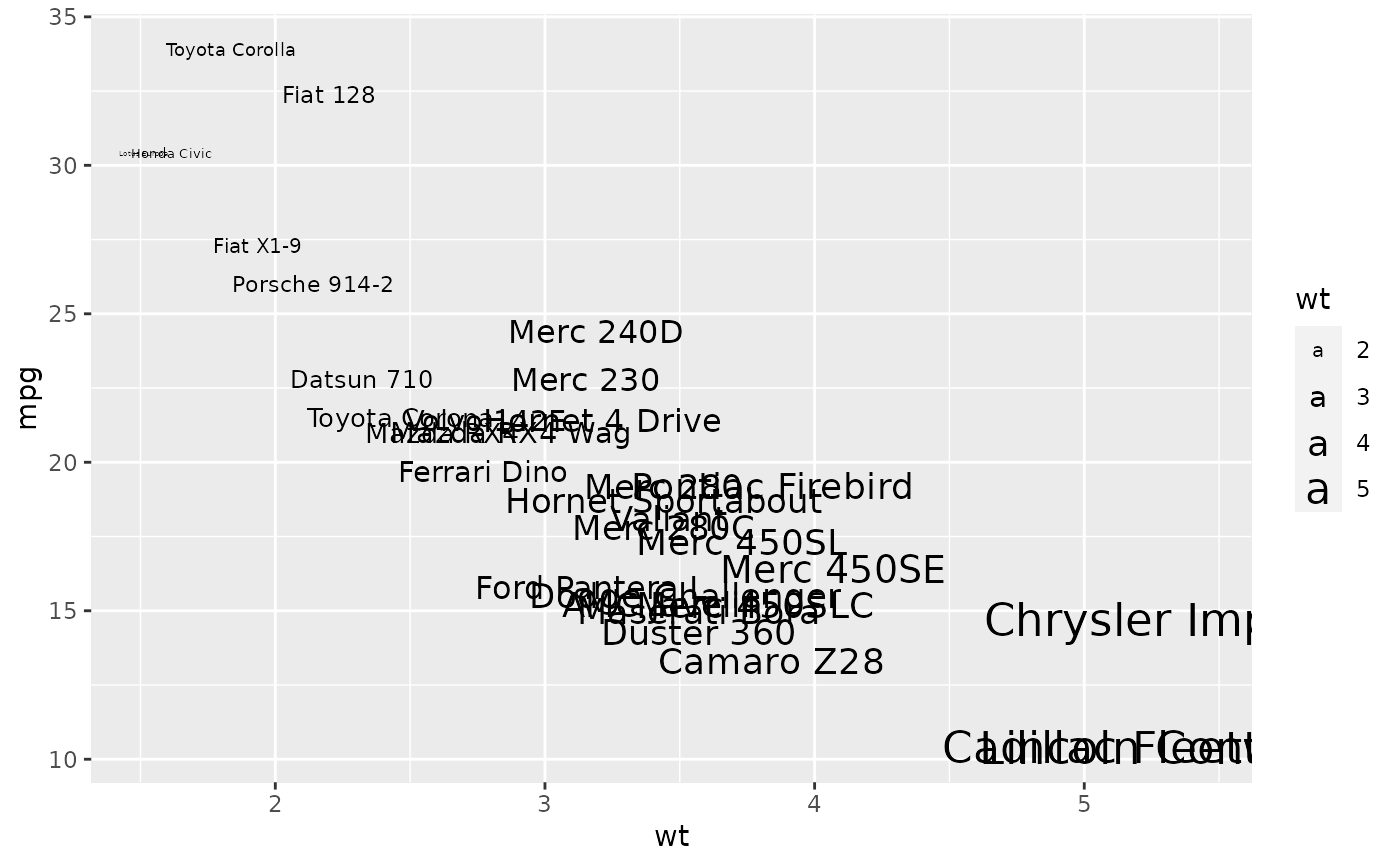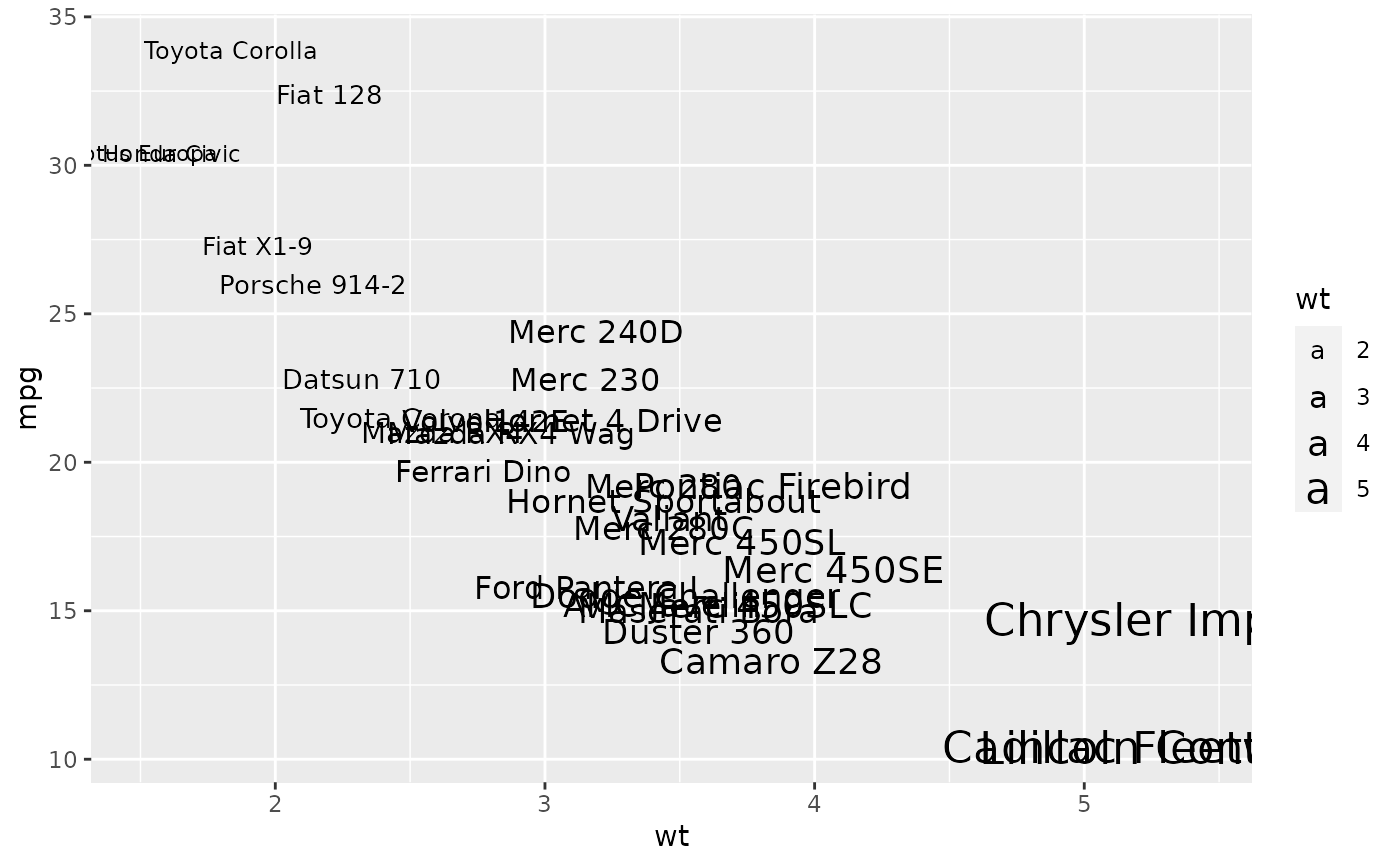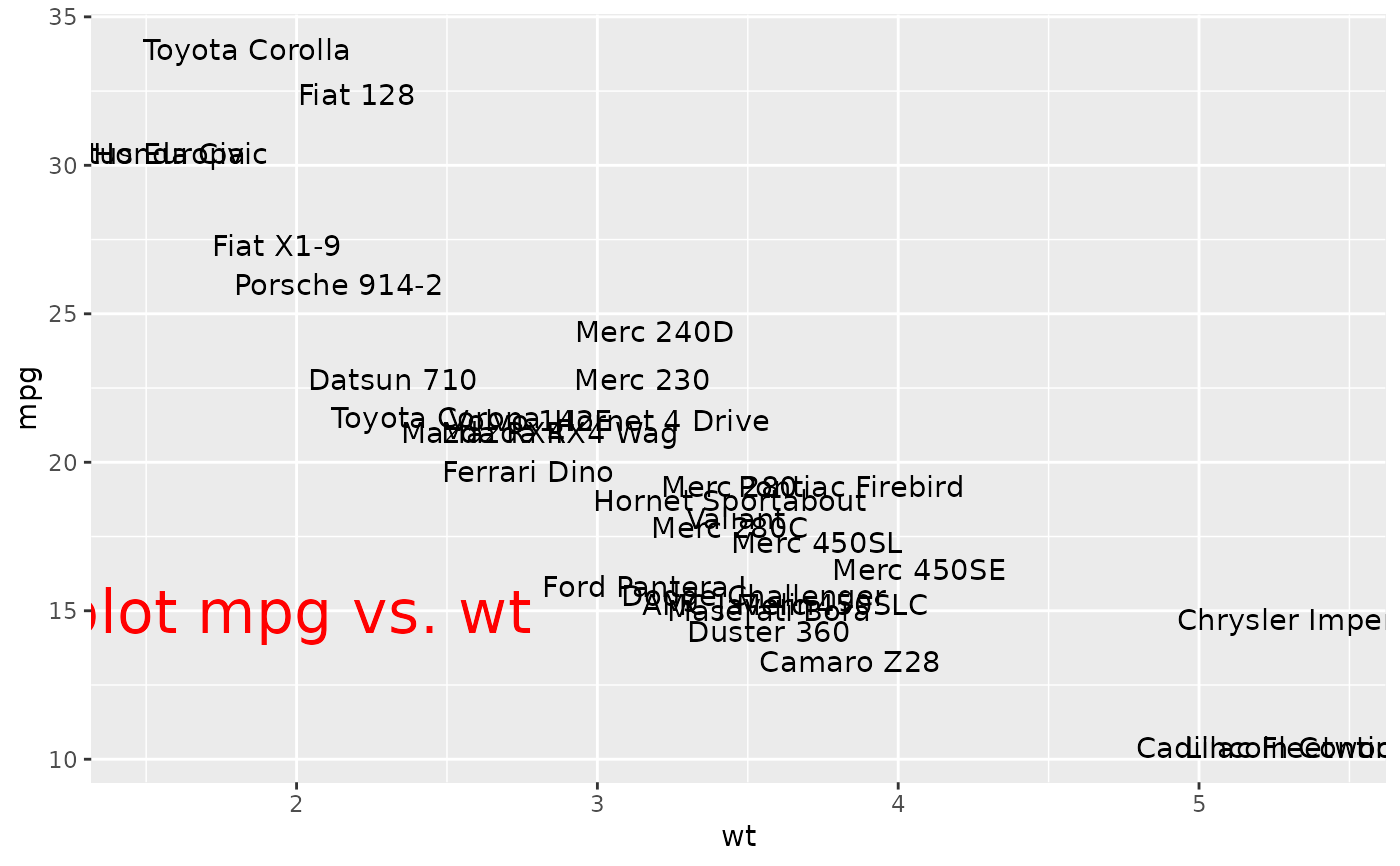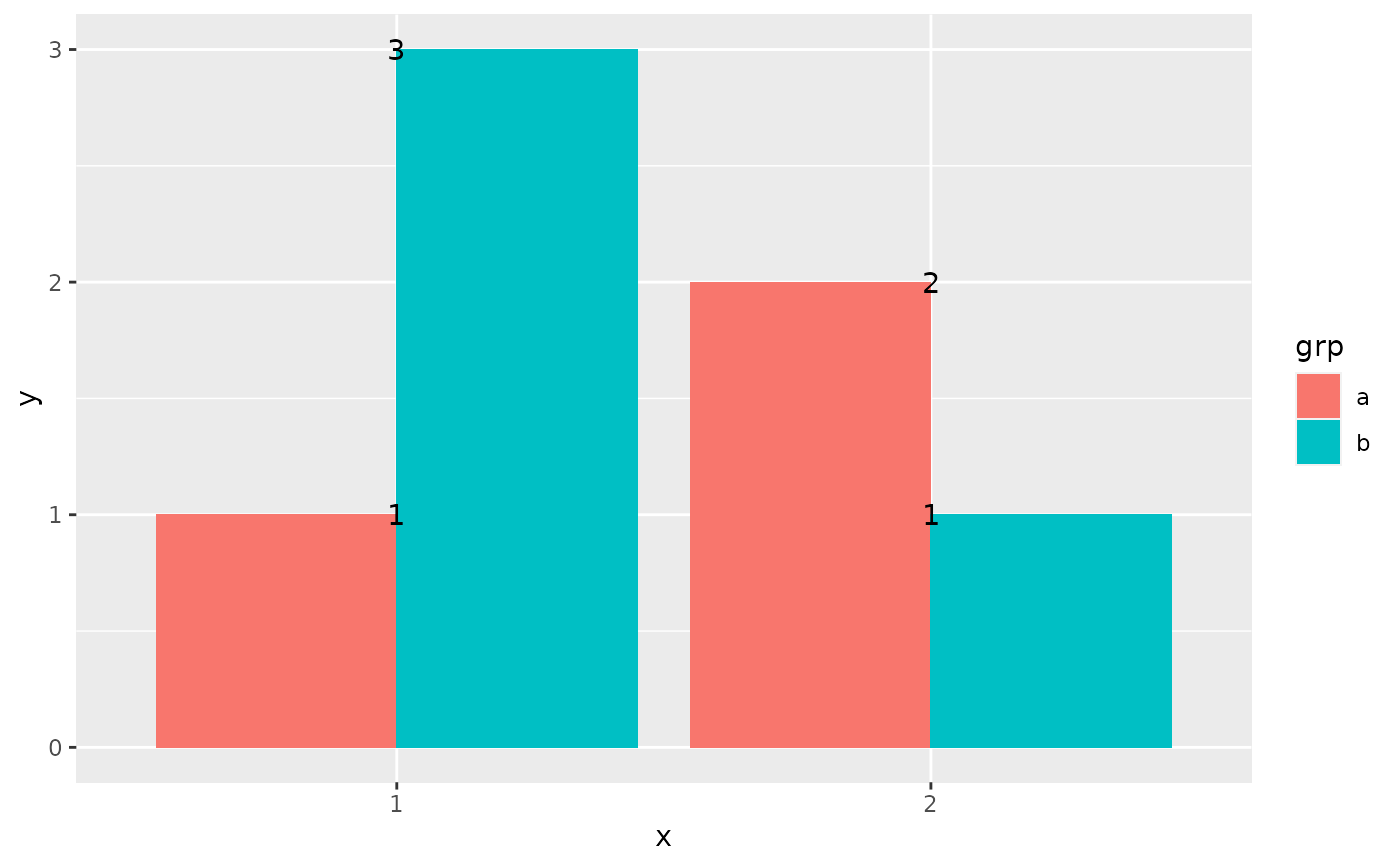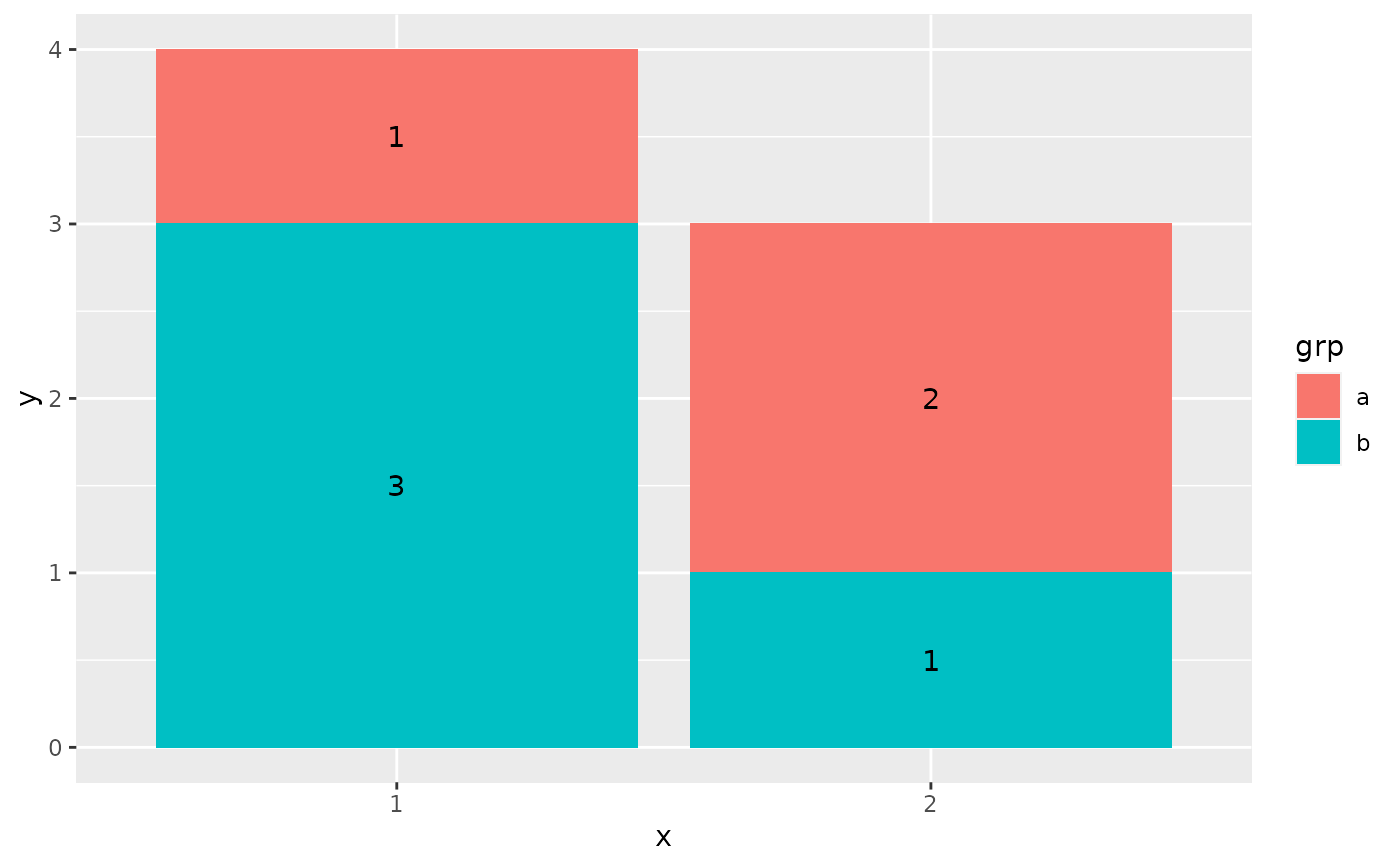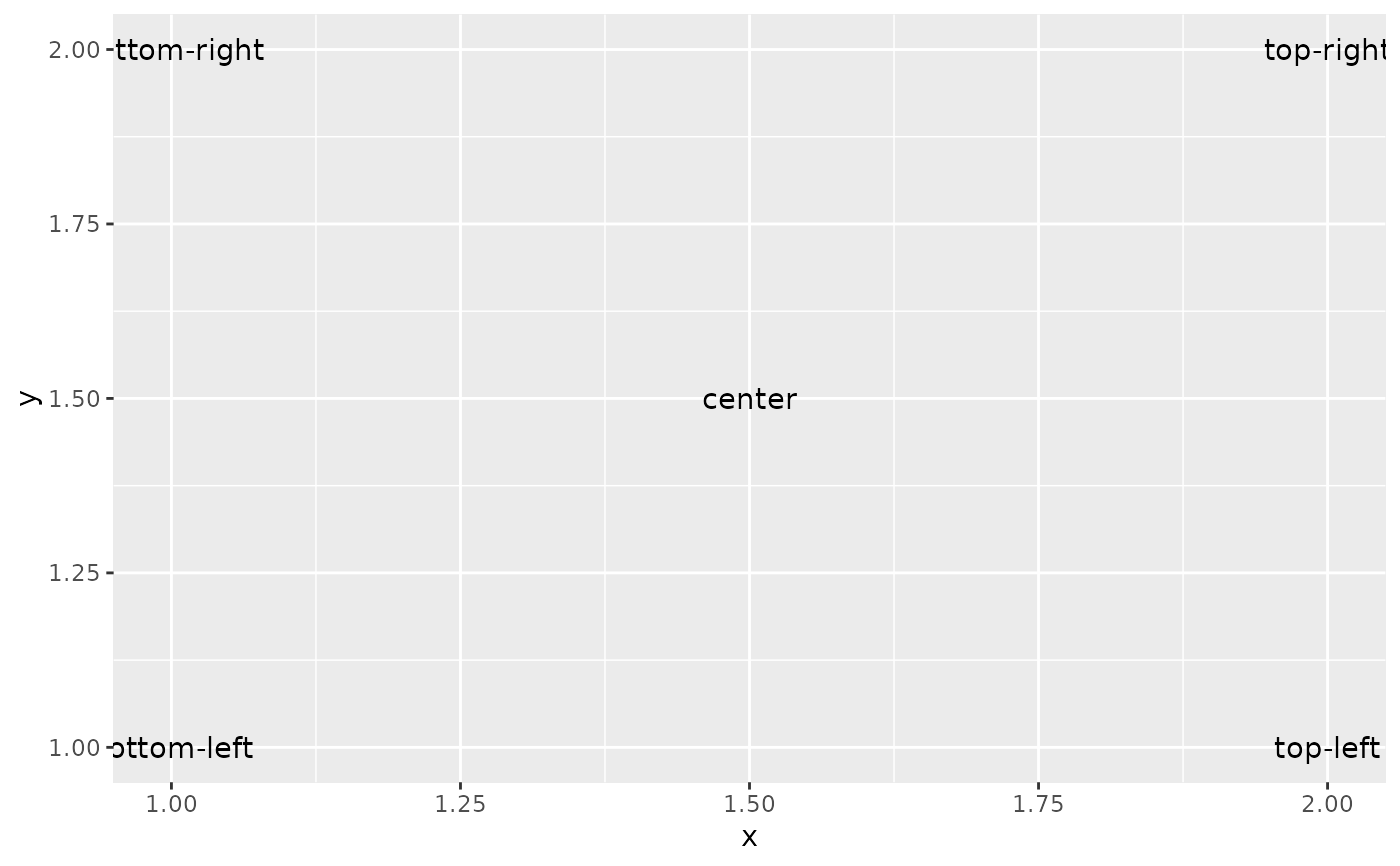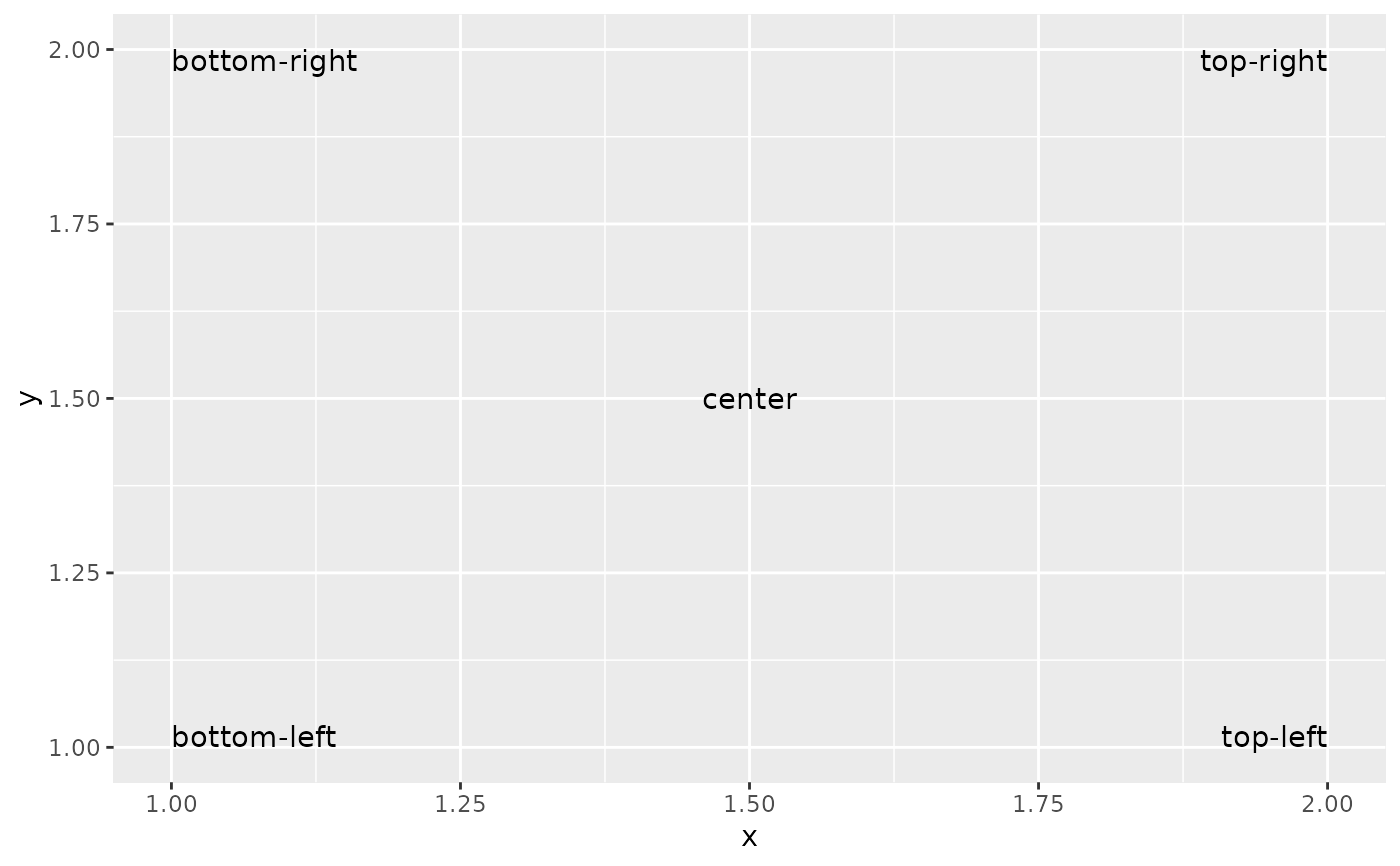Text geoms are useful for labeling plots. They can be used by themselves as
scatterplots or in combination with other geoms, for example, for labeling
points or for annotating the height of bars. geom_text() adds only text
to the plot. geom_label() draws a rectangle behind the text, making it
easier to read.
geom_label( mapping = NULL, data = NULL, stat = "identity", position = "identity", ..., parse = FALSE, nudge_x = 0, nudge_y = 0, label.padding = unit(0.25, "lines"), label.r = unit(0.15, "lines"), label.size = 0.25, na.rm = FALSE, show.legend = NA, inherit.aes = TRUE ) geom_text( mapping = NULL, data = NULL, stat = "identity", position = "identity", ..., parse = FALSE, nudge_x = 0, nudge_y = 0, check_overlap = FALSE, na.rm = FALSE, show.legend = NA, inherit.aes = TRUE )
Arguments
| mapping | Set of aesthetic mappings created by |
|---|---|
| data | The data to be displayed in this layer. There are three options: If A A |
| stat | The statistical transformation to use on the data for this layer, as a string. |
| position | Position adjustment, either as a string, or the result of
a call to a position adjustment function. Cannot be jointy specified with
|
| ... | Other arguments passed on to |
| parse | If |
| nudge_x, nudge_y | Horizontal and vertical adjustment to nudge labels by.
Useful for offsetting text from points, particularly on discrete scales.
Cannot be jointly specified with |
| label.padding | Amount of padding around label. Defaults to 0.25 lines. |
| label.r | Radius of rounded corners. Defaults to 0.15 lines. |
| label.size | Size of label border, in mm. |
| na.rm | If |
| show.legend | logical. Should this layer be included in the legends?
|
| inherit.aes | If |
| check_overlap | If |
Details
Note that when you resize a plot, text labels stay the same size, even though the size of the plot area changes. This happens because the "width" and "height" of a text element are 0. Obviously, text labels do have height and width, but they are physical units, not data units. For the same reason, stacking and dodging text will not work by default, and axis limits are not automatically expanded to include all text.
geom_text() and geom_label() add labels for each row in the
data, even if coordinates x, y are set to single values in the call
to geom_label() or geom_text().
To add labels at specified points use annotate() with
annotate(geom = "text", ...) or annotate(geom = "label", ...).
To automatically position non-overlapping text labels see the ggrepel package.
Aesthetics
geom_text() understands the following aesthetics (required aesthetics are in bold):
xylabelalphaanglecolourfamilyfontfacegrouphjustlineheightsizevjust
Learn more about setting these aesthetics in vignette("ggplot2-specs").
geom_label()
Currently geom_label() does not support the check_overlap argument
or the angle aesthetic. Also, it is considerably slower than geom_text().
The fill aesthetic controls the background colour of the label.
Alignment
You can modify text alignment with the vjust and hjust
aesthetics. These can either be a number between 0 (right/bottom) and
1 (top/left) or a character ("left", "middle", "right", "bottom",
"center", "top"). There are two special alignments: "inward" and
"outward". Inward always aligns text towards the center, and outward
aligns it away from the center.
Examples
# Avoid overlaps p + geom_text(check_overlap = TRUE)# Labels with background p + geom_label()# Change size of the label p + geom_text(size = 10)if (FALSE) { # Doesn't work on all systems p + geom_text(family = "Times New Roman") } # Add aesthetic mappings p + geom_text(aes(colour = factor(cyl)))# Scale height of text, rather than sqrt(height) p + geom_text(aes(size = wt)) + scale_radius(range = c(3,6))# You can display expressions by setting parse = TRUE. The # details of the display are described in ?plotmath, but note that # geom_text uses strings, not expressions. p + geom_text( aes(label = paste(wt, "^(", cyl, ")", sep = "")), parse = TRUE )# Add a text annotation p + geom_text() + annotate( "text", label = "plot mpg vs. wt", x = 2, y = 15, size = 8, colour = "red" )# \donttest{ # Aligning labels and bars -------------------------------------------------- df <- data.frame( x = factor(c(1, 1, 2, 2)), y = c(1, 3, 2, 1), grp = c("a", "b", "a", "b") ) # ggplot2 doesn't know you want to give the labels the same virtual width # as the bars: ggplot(data = df, aes(x, y, group = grp)) + geom_col(aes(fill = grp), position = "dodge") + geom_text(aes(label = y), position = "dodge")#> Warning: Width not defined. Set with `position_dodge(width = ?)`# So tell it: ggplot(data = df, aes(x, y, group = grp)) + geom_col(aes(fill = grp), position = "dodge") + geom_text(aes(label = y), position = position_dodge(0.9))# Use you can't nudge and dodge text, so instead adjust the y position ggplot(data = df, aes(x, y, group = grp)) + geom_col(aes(fill = grp), position = "dodge") + geom_text( aes(label = y, y = y + 0.05), position = position_dodge(0.9), vjust = 0 )# To place text in the middle of each bar in a stacked barplot, you # need to set the vjust parameter of position_stack() ggplot(data = df, aes(x, y, group = grp)) + geom_col(aes(fill = grp)) + geom_text(aes(label = y), position = position_stack(vjust = 0.5))# Justification ------------------------------------------------------------- df <- data.frame( x = c(1, 1, 2, 2, 1.5), y = c(1, 2, 1, 2, 1.5), text = c("bottom-left", "bottom-right", "top-left", "top-right", "center") ) ggplot(df, aes(x, y)) + geom_text(aes(label = text))# }
